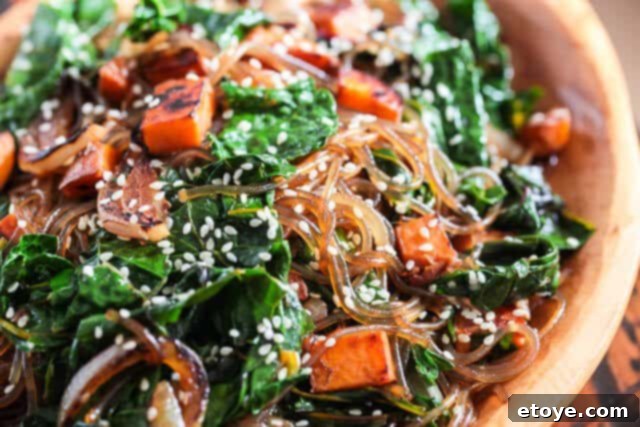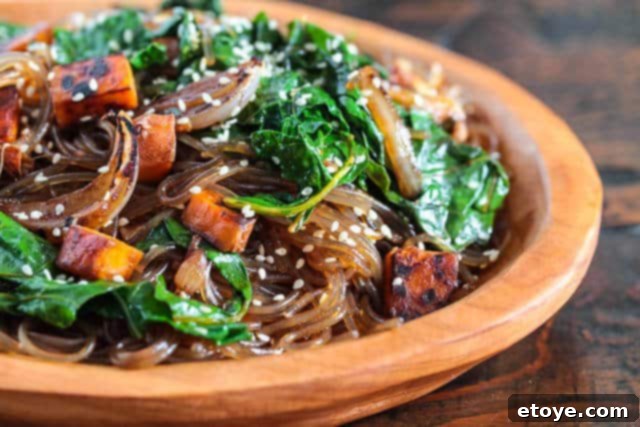
Discover the Delight of Vegetarian Korean Japchae Noodles: A Wholesome & Flavorful Experience
As the vibrant seasons shift, our gardens offer a bounty of fresh produce, inspiring culinary adventures right in our own kitchens. Recently, a generous bucket of sweet potatoes was harvested from Scott’s garden, while my raised beds, after a prolific spring, yielded the last tender leaves of kale and Swiss chard. With the summer heat making outdoor gardening a challenge – save for the resilient chili peppers and okra – it was time to transform these garden treasures into something truly special.
Our choice? Japchae, one of Korea’s most beloved and visually stunning dishes. Often referred to as “Glass Noodles,” Japchae is an incredibly versatile and satisfying meal that effortlessly caters to a wide array of dietary preferences. Whether you’re vegetarian, vegan, gluten-free, or simply looking for a wholesome and delicious dish, Japchae promises to impress and delight everyone at the table (perhaps with the exception of the most ardent meat-only eaters!).

What Exactly Are Dangmyeon Noodles? The Heart of Authentic Japchae
At the core of any authentic Japchae dish are dangmyeon noodles, famously known as Korean glass noodles. These unique noodles are crafted from sweet potato starch, making them a fantastic choice for a variety of dietary needs. They are naturally vegan, gluten-free, paleo-friendly, dairy-free, soy-free, and peanut-free, ensuring that almost everyone can enjoy this flavorful dish without concern.
While many packages at Asian markets confidently state “sweet potato starch” as the sole ingredient, it’s a common curiosity whether there might be other subtle components. Regardless, their magical properties remain: dangmyeon noodles possess an irresistible stretchy, slightly chewy, and wonderfully springy texture. Unlike many other noodle varieties, their neutral flavor profile is a distinct advantage, as it allows them to act like a culinary sponge, eagerly absorbing every nuanced flavor of the accompanying sauce and vegetables. This incredible absorbency means less seasoning is needed directly on the noodles, letting the vibrant flavors of the entire dish shine through.
The Cultural Significance and Appeal of Japchae
Japchae, meaning “mixed vegetables,” has a rich history in Korean cuisine, dating back to the 17th century. Originally, it was a royal court dish made without noodles, consisting solely of stir-fried vegetables. Over time, as dangmyeon noodles became more accessible, they were incorporated, elevating the dish to the iconic status it holds today. It’s a celebratory food, frequently served during holidays, special occasions, and family gatherings, symbolizing prosperity and good fortune.
The beauty of Japchae lies not only in its taste but also in its colorful presentation. Each ingredient is typically cooked separately and then combined, allowing their individual textures and flavors to remain distinct. This meticulous preparation results in a vibrant medley of colors—deep greens from spinach or kale, bright oranges from carrots or sweet potatoes, the translucent sheen of the noodles, and the rich brown of the soy sauce-based seasoning—making it as appealing to the eye as it is to the palate.
Unleashing the Inner Child: The Playful Side of Glass Noodles
Beyond their culinary prowess, these elastic dangmyeon noodles possess another, rather unexpected, talent: they are fantastic for a spirited food fight! Their incredible stretchiness allows for some truly epic, albeit messy, fun. A simple flick of the wrist can send a tangle of stinging wet noodles flying towards an unsuspecting opponent. Just ask my boys, who can confirm the sheer joy (and subsequent chaos) of a good noodle battle. We even captured some of their antics in the recipe video – watch until the end to see their noodle-slinging prowess!
While ten minutes of food-fighting fun might lead to forty minutes of cleanup, the laughter and memories created are, according to the boys, entirely worth it. My camera lens, however, tells a different story – it wasn’t quite as thrilled about being caught in the crossfire! But it’s a testament to the unique and versatile nature of these noodles, proving they can bring joy both on and off the plate.
Mastering the Art of Vegetarian Korean Japchae: Your Step-by-Step Guide
Embark on your own culinary journey with this comprehensive guide to crafting a delicious and healthy Vegetarian Korean Japchae. This “Super Foods Version” emphasizes nutrient-rich ingredients like sweet potatoes, kale, and Swiss chard, ensuring a meal that is both incredibly tasty and beneficial for your well-being.
For a visual walkthrough and extra tips, don’t forget to watch the accompanying video, which guides you through each step of the preparation process. It clearly demonstrates the key technique of cooking each ingredient separately, ensuring perfect textures and vibrant flavors in your final dish.


Korean Japchae Glass Noodles Recipe – Super Foods Version!
The key to this recipe is adding each ingredient separately, as demonstrated in the video. The sweet potato takes the longest to cook, so it’s added first to ensure it reaches perfect tenderness.
Feel free to customize this dish to your liking! Enhance its nutritional profile and flavor by adding ingredients like sliced mushrooms (incorporate them with the onions), matchstick carrots, or fresh spinach leaves (add them at the same time as the kale/Swiss chard). This recipe is incredibly adaptable to whatever fresh vegetables you have on hand.
Pin Recipe
Ingredients
- 6 oz dried Korean glass noodles (sweet potato)
- 1 medium sweet potato
- 4 big handfuls kale and Swiss chard
- 1 onion
- 1 stalk green onion
- 3-4 cloves garlic
- 1/2 cup soy sauce
- 2 tablespoons brown sugar
- 1 tablespoon sesame oil
- 1 tablespoon roasted sesame seeds
- 1 tablespoon cooking oil
Instructions
PREP INGREDIENTS:
- Boil a pot of water (approximately 2 quarts). Once boiling, turn off the heat and add the dried glass noodles. Allow them to sit and soften for 10 minutes.
- For the Kale/Swiss Chard: Fold each leaf in half lengthwise and tear away the leafy green part from the tough central stem. Discard the stems. Cut or tear the remaining leaves into bite-sized pieces for easier eating.
- Dice the sweet potatoes into 1/2-inch cubes. Remember, smaller dice will cook more quickly and evenly.
- Slice the onion thinly, creating delicate strips that will caramelize nicely.
- Chop the green onion into small, manageable pieces.
- Finely mince the garlic cloves to ensure their flavor is well distributed throughout the dish.
- In a medium bowl, whisk together the soy sauce, brown sugar, and sesame oil until the sugar is fully dissolved, forming your savory-sweet sauce.
- Once the 10 minutes for the noodles are up, drain them thoroughly and set aside.
COOK:
- Heat a wok or large skillet over medium heat and add the cooking oil. Introduce the diced sweet potatoes and cook for approximately 3 minutes per side, or until they are lightly browned, a darker orange, and nearly cooked through but still retaining a slight bite.
- Increase the heat to medium-high and add the thinly sliced onions to the wok. Stir-fry for about 2 minutes, or until the onions become beautifully translucent and begin to soften.
- Add the minced garlic and chopped green onion to the wok. Toss well with the other ingredients and cook for about 1 minute, allowing the aromatic flavors to fully develop.
- Introduce the leafy vegetables (kale/Swiss chard) to the wok. Use tongs to toss everything together thoroughly and cook for 1 1/2 minutes, or until the greens have just begun to wilt and turn tender-crisp.
- Finally, add the drained glass noodles to the wok, then pour in the prepared sauce. Toss everything together vigorously to ensure the noodles are evenly coated and all ingredients are well combined. Finish the dish by sprinkling with roasted sesame seeds for an added layer of flavor and texture.
Why You Should Make Japchae: Health Benefits and Versatility
This vegetarian Japchae isn’t just a treat for your taste buds; it’s a powerhouse of nutrition. Sweet potatoes, the star ingredient of the noodles and a key vegetable, are rich in vitamins, especially Vitamin A, and dietary fiber, promoting digestive health and providing sustained energy. Kale and Swiss chard contribute a wealth of vitamins K, A, and C, along with essential minerals and antioxidants, supporting bone health, immune function, and overall vitality.
By cooking the ingredients separately, we not only preserve their distinct flavors and textures but also retain more of their nutritional integrity. This method ensures that your Japchae is a balanced meal, packed with fiber from the vegetables, complex carbohydrates from the sweet potato noodles, and an abundance of micronutrients. It’s a fantastic way to enjoy a “super food” meal that feels indulgent yet is incredibly good for you.
Beyond its nutritional value, Japchae’s versatility makes it a perfect addition to any meal plan. Serve it as a delightful main course for a light lunch or dinner, or as a vibrant side dish to complement other Asian-inspired meals. It tastes wonderful both warm and at room temperature, making it an excellent option for meal prepping or bringing to potlucks. You can easily adjust the spice level to your preference by adding a pinch of red pepper flakes, or incorporate different proteins like pan-fried tofu or tempeh for an extra boost.
Tips for Japchae Perfection
- Noodle Prep is Key: Don’t overcook the glass noodles. They should be chewy and springy, not mushy. Soaking them in hot water off the heat is ideal for achieving this texture.
- Wok Hei (or Skillet Sizzle): Cooking over medium-high heat is crucial for stir-frying. This allows the vegetables to caramelize slightly and develop rich flavors without becoming watery.
- Separate Cooking for Best Results: While it might seem like an extra step, cooking ingredients individually is what makes traditional Japchae so special. It ensures each component is perfectly cooked and retains its unique character.
- Balance the Sauce: Taste your sauce before adding it. Adjust the sweetness or saltiness to match your preference. A touch more brown sugar for sweetness or soy sauce for umami can make a big difference.
- Fresh Garnishes: A sprinkle of fresh chopped green onions or a drizzle of extra sesame oil just before serving can elevate the dish significantly.
This vegetarian Korean Japchae recipe offers a wonderful blend of tradition, flavor, and health. It’s a testament to how simple, fresh ingredients can come together to create a dish that is both satisfying and incredibly versatile. So, gather your garden’s bounty, or visit your local market, and prepare to be enchanted by the delicate chewiness of glass noodles intertwined with savory vegetables. Enjoy the process of creating this beautiful and delicious meal!
